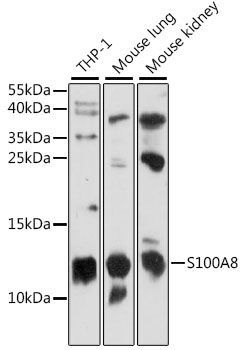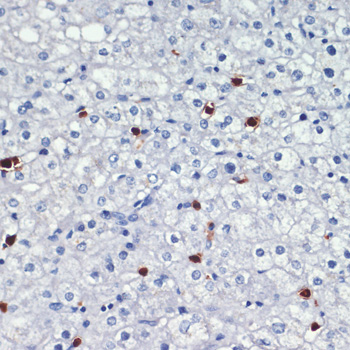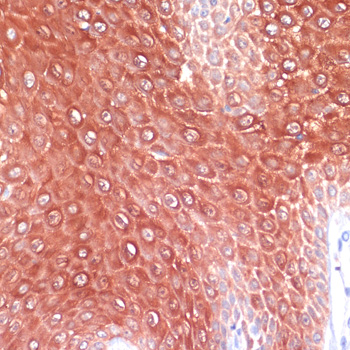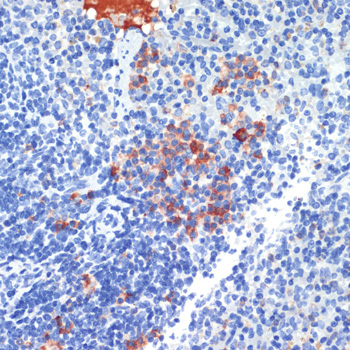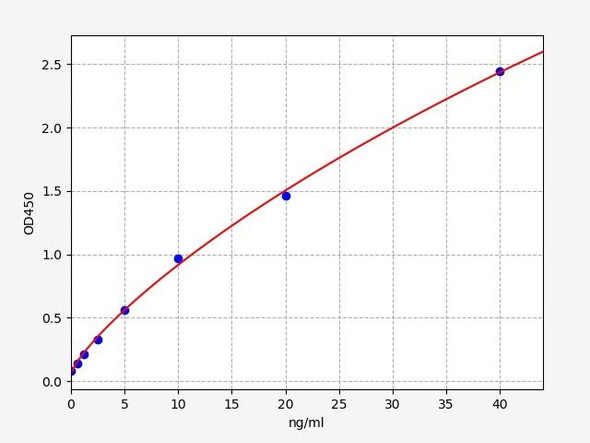Cell Death Antibodies 1
Anti-S100A8 Antibody (CAB15315)
- SKU:
- CAB15315
- Product Type:
- Antibody
- Reactivity:
- Human
- Reactivity:
- Mouse
- Reactivity:
- Rat
- Host Species:
- Rabbit
- Isotype:
- IgG
- Antibody Type:
- Polyclonal Antibody
- Research Area:
- Cell Death
Description
| Antibody Name: | Anti-S100A8 Antibody |
| Antibody SKU: | CAB15315 |
| Antibody Size: | 20uL, 50uL, 100uL |
| Application: | WB IHC IF |
| Reactivity: | Human, Mouse, Rat |
| Host Species: | Rabbit |
| Immunogen: | Recombinant fusion protein containing a sequence corresponding to amino acids 1-93 of human S100A8 (NP_002955.2). |
| Application: | WB IHC IF |
| Recommended Dilution: | WB 1:500 - 1:2000 IHC 1:50 - 1:100 IF 1:50 - 1:100 |
| Reactivity: | Human, Mouse, Rat |
| Positive Samples: | THP-1, Mouse lung, Mouse kidney |
| Immunogen: | Recombinant fusion protein containing a sequence corresponding to amino acids 1-93 of human S100A8 (NP_002955.2). |
| Purification Method: | Affinity purification |
| Storage Buffer: | Store at -20'C. Avoid freeze / thaw cycles. Buffer: PBS with 0.02% sodium azide, 50% glycerol, pH7.3. |
| Isotype: | IgG |
| Sequence: | MLTE LEKA LNSI IDVY HKYS LIKG NFHA VYRD DLKK LLET ECPQ YIRK KGAD VWFK ELDI NTDG AVNF QEFL ILVI KMGV AAHK KSHE ESHK E |
| Gene ID: | 6279 |
| Uniprot: | P05109 |
| Cellular Location: | Cell membrane, Cytoplasm, Peripheral membrane protein, Secreted, cytoskeleton |
| Calculated MW: | 10kDa |
| Observed MW: | 11kDa |
| Synonyms: | S100A8, 60B8AG, CAGA, CFAG, CGLA, CP-10, L1Ag, MA387, MIF, MRP8, NIF, P8 |
| Background: | The protein encoded by this gene is a member of the S100 family of proteins containing 2 EF-hand calcium-binding motifs. S100 proteins are localized in the cytoplasm and/or nucleus of a wide range of cells, and involved in the regulation of a number of cellular processes such as cell cycle progression and differentiation. S100 genes include at least 13 members which are located as a cluster on chromosome 1q21. This protein may function in the inhibition of casein kinase and as a cytokine. Altered expression of this protein is associated with the disease cystic fibrosis. Multiple transcript variants encoding different isoforms have been found for this gene. |
| UniProt Protein Function: | S100A8: S100A8 is a calcium- and zinc-binding protein which plays a prominent role in the regulation of inflammatory processes and immune response. It can induce neutrophil chemotaxis and adhesion. Predominantly found as calprotectin (S100A8/A9) which has a wide plethora of intra- and extracellular functions. The intracellular functions include: facilitating leukocyte arachidonic acid trafficking and metabolism, modulation of the tubulin-dependent cytoskeleton during migration of phagocytes and activation of the neutrophilic NADPH-oxidase. Activates NADPH- oxidase by facilitating the enzyme complex assembly at the cell membrane, transfering arachidonic acid, an essential cofactor, to the enzyme complex and S100A8 contributes to the enzyme assembly by directly binding to NCF2/P67PHOX. The extracellular functions involve proinfammatory, antimicrobial, oxidant-scavenging and apoptosis-inducing activities. Its proinflammatory activity includes recruitment of leukocytes, promotion of cytokine and chemokine production, and regulation of leukocyte adhesion and migration. Acts as an alarmin or a danger associated molecular pattern (DAMP) molecule and stimulates innate immune cells via binding to pattern recognition receptors such as Toll-like receptor 4 (TLR4) and receptor for advanced glycation endproducts (AGER). Binding to TLR4 and AGER activates the MAP-kinase and NF- kappa-B signaling pathways resulting in the amplification of the proinflammatory cascade. Has antimicrobial activity towards bacteria and fungi and exerts its antimicrobial activity probably via chelation of Zn(2+) which is essential for microbial growth. Can induce cell death via autophagy and apoptosis and this occurs through the cross-talk of mitochondria and lysosomes via reactive oxygen species (ROS) and the process involves BNIP3. Can regulate neutrophil number and apoptosis by an anti-apoptotic effect; regulates cell survival via ITGAM/ITGB and TLR4 and a signaling mechanism involving MEK-ERK. Its role as an oxidant scavenger has a protective role in preventing exaggerated tissue damage by scavenging oxidants. Can act as a potent amplifier of inflammation in autoimmunity as well as in cancer development and tumor spread. Belongs to the S-100 family. |
| UniProt Protein Details: | Chromosomal Location of Human Ortholog: 1q21 Cellular Component: extracellular space; cytoskeleton; extracellular region; plasma membrane; cytosol; nucleus Molecular Function:arachidonic acid binding; protein binding; RAGE receptor binding; zinc ion binding; microtubule binding; calcium ion binding Biological Process: caspase activation; neutrophil chemotaxis; chronic inflammatory response; chemokine production; wound healing; cytokine production; response to lipopolysaccharide; positive regulation of peptide secretion; positive regulation of cell growth; leukocyte migration during inflammatory response; activation of NF-kappaB transcription factor; sequestering of zinc ion; response to ethanol; response to zinc ion; defense response to bacterium; innate immune response; autophagy; inflammatory response; defense response to fungus; acute inflammatory response; positive regulation of inflammatory response; regulation of cytoskeleton organization and biogenesis |
| NCBI Summary: | The protein encoded by this gene is a member of the S100 family of proteins containing 2 EF-hand calcium-binding motifs. S100 proteins are localized in the cytoplasm and/or nucleus of a wide range of cells, and involved in the regulation of a number of cellular processes such as cell cycle progression and differentiation. S100 genes include at least 13 members which are located as a cluster on chromosome 1q21. This protein may function in the inhibition of casein kinase and as a cytokine. Altered expression of this protein is associated with the disease cystic fibrosis. [provided by RefSeq, Jul 2008] |
| UniProt Code: | P05109 |
| NCBI GenInfo Identifier: | 115442 |
| NCBI Gene ID: | 6279 |
| NCBI Accession: | P05109.1 |
| UniProt Secondary Accession: | P05109,Q5SY70, Q9UC84, Q9UC92, Q9UCJ0, Q9UCM6, A8K5L3 D3DV37, |
| UniProt Related Accession: | P05109 |
| Molecular Weight: | 93 |
| NCBI Full Name: | Protein S100-A8 |
| NCBI Synonym Full Names: | S100 calcium binding protein A8 |
| NCBI Official Symbol: | S100A8 |
| NCBI Official Synonym Symbols: | P8; MIF; NIF; CAGA; CFAG; CGLA; L1Ag; MRP8; CP-10; MA387; 60B8AG |
| NCBI Protein Information: | protein S100-A8; MRP-8; calgranulin A; calgranulin-A; cystic fibrosis antigen; calprotectin L1L subunit; urinary stone protein band A; leukocyte L1 complex light chain; migration inhibitory factor-related protein 8; S100 calcium-binding protein A8 (calgranulin A) |
| UniProt Protein Name: | Protein S100-A8 |
| UniProt Synonym Protein Names: | Calgranulin-A; Calprotectin L1L subunit; Cystic fibrosis antigen; CFAG; Leukocyte L1 complex light chain; Migration inhibitory factor-related protein 8; MRP-8; p8; S100 calcium-binding protein A8; Urinary stone protein band AProtein S100-A8, N-terminally processed |
| Protein Family: | Protein |
| UniProt Gene Name: | S100A8 |
| UniProt Entry Name: | S10A8_HUMAN |


